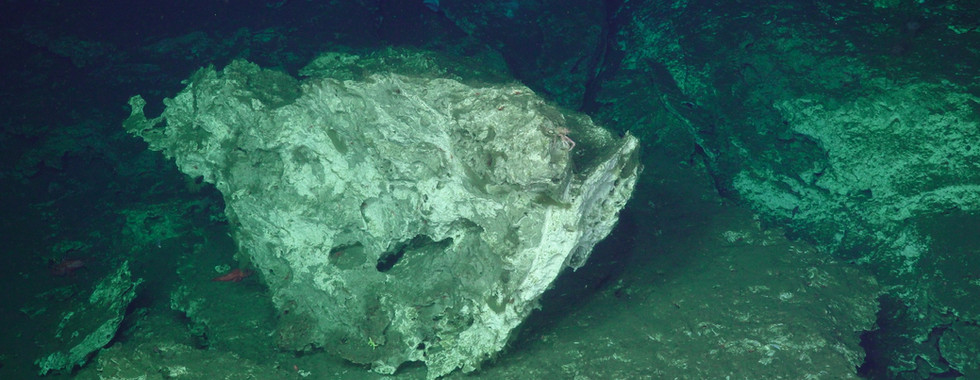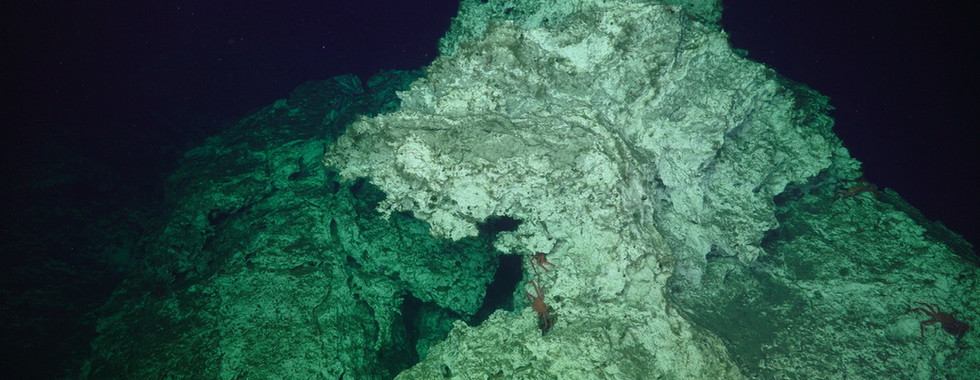At the Eastern margin of the Juan de Fuca Plate, there is a secret oasis in the deep where life abounds – a community supported not by energy from the sun, but by chemicals from beneath the surface of the sediment itself.
This post is part of my Visions23 Cruise Blog, from my time at sea in August on board RV Thomas G Thompson with the Ocean Observatories Initiative / University of Washington. Read more about the cruise here.

Beds of deep-sea clams burrow into matts of chemosynthetic bacteria at the active seep site at Southern Hydrate Ridge. Credit: UW/NSF-OOI/WHOI; J2-1542.
I have just emerged from the Jason control van after perhaps the most exciting night of my professional life. The ROV dove to a site of hydrocarbon seepage called Southern Hydrate Ridge (SHR), and I, at last, got to sit in the hot-seat, operating the 4K camera and leading the dive for almost 10 hours. The aim of the dive was to conduct a geological and biological survey across numerous sites of interest along the ridge, recording and observing the life we encountered, while also collecting footage for the film I’ll be creating about the expedition upon my return. This is also part of an annual survey to document sites of venting in case the focused site "Einsteins’ Grotto" shuts down.
Cold seeps like SHR are among the deep’s more peculiar offerings in that they are robust and diverse biotopes reliant not on slow-sinking scraps of marine snow, or leftovers from the highly productive photic zone, but on an entirely different source of energy altogether: methane! But how did hydrocarbons like methane get here in the first place? As marine life dies and settles on the seafloor, it gets buried, and sub-surface microbes decompose this material, while producing methane as a byproduct. This builds up; at places where tectonic processes squeeze and scrape sediments, these chemical compounds are released into the ocean.
At this particular site, the SHR methane seep formed as the oceanic Juan de Fuca plate is subducted beneath the continental North American plate at the Cascadia subduction zone.
Look closely at the seafloor here, and you’ll find patches of wispy white “fluff” that carpets the sediments. These are dense matts of chemosynthetic bacteria that undergo the crucial process of converting chemical energy from the methane into a food source (instead of converting sunlight energy, as we observe in photosynthetic organisms such as phytoplankton). It’s a process that mirrors photosynthesis in many ways, and similarly supports abundant animal life by forming the base of a complex food web.

Clam beds live in direct association with these microbes by hosting them within their shells, while sea stars, cucumbers, and snails all graze the mats and make the most of the region’s heightened productivity, gathering in far greater abundances than elsewhere on the deep sea floor. Seeps are hotspots of life, but they support deep biodiversity in another way as well.
Ridges, overhangs, mounds and outcrops of authigenic carbonate mark the activity of microbes anaerobically respiring methane as it seeps from the seafloor. Credit: UW/NSF-OOI/WHOI; J2-1542.
The submarine landscape here is alien. Rising out of the great silt plain, we find grand rocky structures. Mounds, ridges and overhangs of textured carbonate – reefs of authigenic rock, meaning “precipitated inorganically in situ” – with fascinating origins! These crusts arise as communities of microbes within sediments anaerobically oxidize the methane, producing HCO3− and HS− as byproducts which increase the alkalinity of pore water (within sediments) and lead to the precipitation of the authigenic carbonates.
The carbonate creates complexity through the creation of towering, 3D structures. This is vital, for complexity drives biodiversity. Although the carbonate may “plug” the seepage over time, the hard surfaces continue to allow sessile animals (immobile and fixed in one place) such as corals and sponges to thrive!
Soft corals of the genus Anthomastus cover the carbonate outcrops, west of the active seep site at Southern Hydrate Ridge. Credit: UW/NSF-OOI/WHOI; J2-1543; V23.

A bubblegum coral stands proud atop the carbonate pinnacle. Credit: UW/NSF-OOI/WHOI; J2-1543.
At Pinnacle, a 50 metre tall carbonate mound located at SHR, the walls and overhangs are covered with otherworldly “mushroom” soft-corals (Anthomastus ritteri). Additionally, the many crevices, nooks, and crannies allow mobile fauna to sequester themselves away and seek shelter from predators.

Squat lobster, hagfish and soft corals at home on the Pinnacle. Credit: UW/NSF-OOI/WHOI; J2-1543; V23.

A hagfish and a rockfish close together in a sedimented area of the Pinnacle. Credit: UW/NSF-OOI/WHOI; J2-1543; V23.

A deep-sea skate and several crabs were sighted on the soft-sedimented region just south of the active seep at SHR. Credit: UW/NSF-OOI/WHOI; J2-1543; V23.
South of the active seep site at SHR, there is another strange world. An odd sight to behold, the landscape here resembles a great, flat shrine of candles laid out in clusters atop a plain of scattered carbonate rocks (or corn cobs - the choice is yours). This is the Neptunea nursery, and the “candles” are spiral egg stalks for a species of deep-sea snail of the genus Neptunea. During our visit, only the stalks were present, but in previous years the adult snails have oft been seen sitting atop their creations. It is thought that once the eggs hatch, the parent snails fall off and die.
Neptunea egg stalks, tiny shrimp and a crab make use of the carbonate clasts. Credit: UW/NSF-OOI/WHOI; J2-1542; V23.

Adult Neptunea snails sit atop their egg-stalk structures, taken in 2014. Credit UW/NSF-OOI/CSSF; ROPOS dive 1758; V14.
After wrapping up the biology survey, and with still some time to go before the ROV was to be recovered, the pilot Mario invited me to pilot Jason itself for a little while. The opportunity felt tremendously special, and after being shown how to maneuver, change heading, and what to look out for on the many screens to ensure I did not crash this multi-million dollar vehicle into the seabed, I was given free reign to traverse the site. It immediately felt a more intimate experience controlling the ROV itself compared to simply watching from the hot-seat. Seeing the vehicle respond to every button-press and lever-pull, and knowing that the many wonders on-screen were now within reach, the great and mysterious deep-ocean realm which I have adored and revered for so many years felt at last closer than ever!
After a short while, Mario invited me to reach to my right and pull out another controller. This one looked a little different. A piece of jointed metal armature in miniature, this was the controller for Jason’s starboard manipulator. After positioning it to resemble closely the current resting position of the real arm, pressing the large button at the end of the controller unlocked the manipulator and allowed it to be moved through delicate repositioning of its miniature counterpart. This was truly something out of science-fiction. As per Mario’s instructions, I lowered the arm to the seafloor, opened the grabber, and picked up a hefty carbonate rock, before bringing it into view of the cameras.
Mario joked I should bring it back and keep it. Unfortunately, it was twice the size of my head…

The rock I picked up while in control of Jason and its starboard manipulator arm. Credit: UW/NSF-OOI/WHOI; J2-1542; V23.
Many months later...
It's been 8 months since I found myself back on dry land following the Visions23 expedition, and finishing up this post completely slipped my mind, for I have the brain of a sieve! I've had a lot of time to reflect on the experience, and I want to say a few words on marine exploration on the whole.
Those of you who are familiar with me and my work will know (at the time of writing) I am still a student, studying marine biology in the UK, creating films and other content like these articles primarily as a passion project. In the 12 years since I put out my first film at age 9, inspired by Attenborough and in awe of natural history, this has bloomed into a career in sci-comm very much in the vein of a 'dream job'. I used to think on marine research vessels the way a kid obsessed with space might ponder on becoming an Astronaut, setting out among the stars on a voyage en-par with the Apollo missions. For me, to finally be in the thick of it, 300 miles out, swallowed by endless blue while surrounded by passionate scientists, experts of seemingly limitless knowledge, and ships' crew who spent months on end among the waves for few reasons beyond a love of the surge and sway or the humming of the engine, it was like nothing I had experienced! To do such a thing, and be involved in this world, whether as a scientist or deckhand, seemed in every single person I encountered to be a labour of love. Deep, unwavering love. For some, the lifestyle was their draw. For others, the fish, the vibrancy of life the ocean nurtured. For a few, it was the waves - the existential awe of peering over the bow and beholding this great rolling entity that held within so much power and so many unknowns, yet would take your life in an instant should you fall!
For me, I believe it to be a mix of all those things. The ocean commands such adoration. You can sense it when you stand on a shore and peer out among the skerries and the stacks, and feel the swash fold over your feet so gently, knowing it ground the sand and carved the stone on the cliff-face. But when it surrounds you on all sides, and you are truly held within its arms, its majesty soars!
If you are at all interested in the ocean, or the life within, or even engineering, mechanics, physics, becoming a deckhand, or science communication like me (there are so many ways to get involved in this space via so many routes, not just higher education), pursue those passions!! Speak to people in the industry, express your interest to learn, and to gain experience. And if you should ever want advice, reach out to me - I'll be more than happy to help. :)
Leo Richards
Creator of Natural World Facts | Science communicator | Wildlife presenter & film-maker
Photos by Leo Richards and fellow Visions voyagers.
To find out more about Visions23 and the Regional Cabled Array, as well as tune in to watch ROV Jason's deep-sea dives live, click here.
To watch my deep-sea films and discover the wonders of life in the depths, click here.



































Keep it up ! 😃